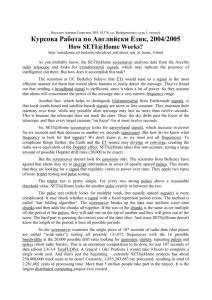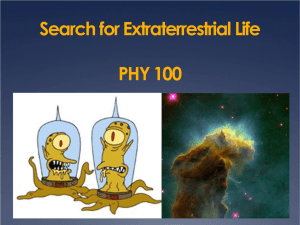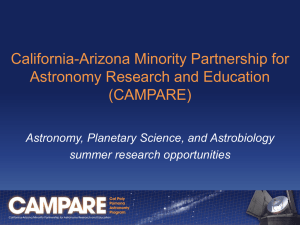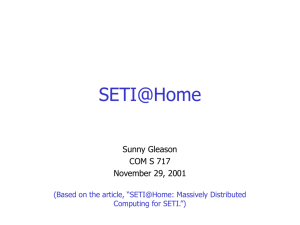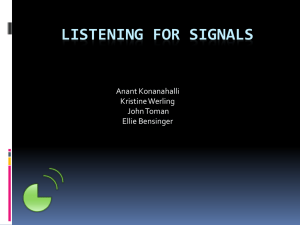Contact: UFOlogy and SETI
advertisement
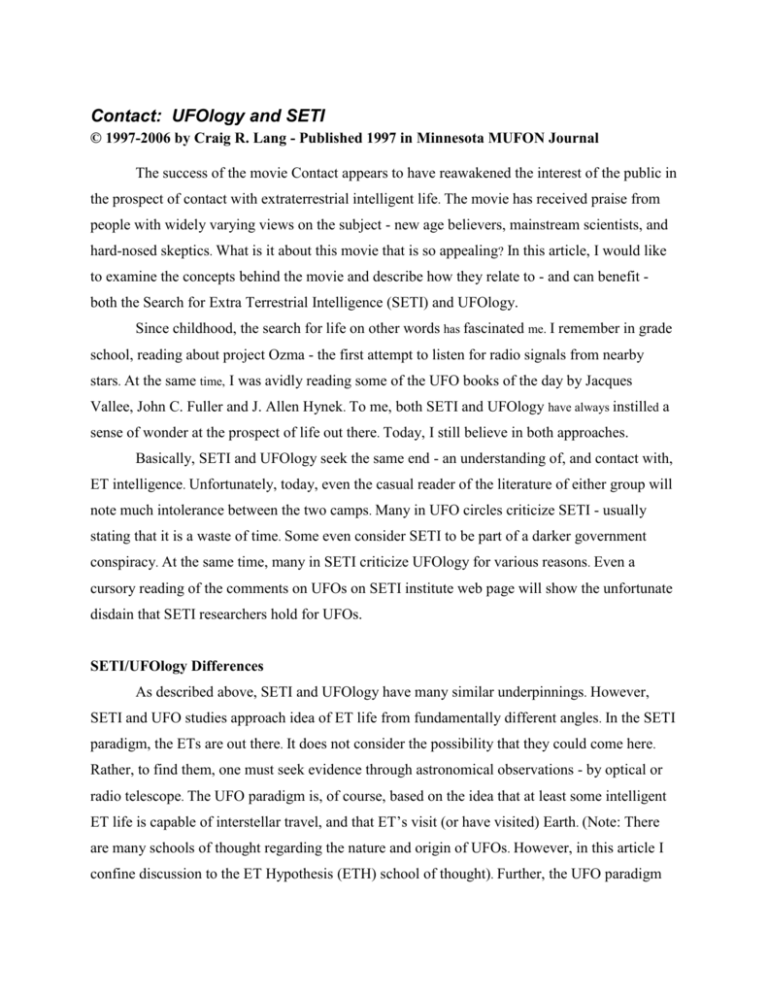
Contact: UFOlogy and SETI © 1997-2006 by Craig R. Lang - Published 1997 in Minnesota MUFON Journal The success of the movie Contact appears to have reawakened the interest of the public in the prospect of contact with extraterrestrial intelligent life. The movie has received praise from people with widely varying views on the subject - new age believers, mainstream scientists, and hard-nosed skeptics. What is it about this movie that is so appealing? In this article, I would like to examine the concepts behind the movie and describe how they relate to - and can benefit both the Search for Extra Terrestrial Intelligence (SETI) and UFOlogy. Since childhood, the search for life on other words has fascinated me. I remember in grade school, reading about project Ozma - the first attempt to listen for radio signals from nearby stars. At the same time, I was avidly reading some of the UFO books of the day by Jacques Vallee, John C. Fuller and J. Allen Hynek. To me, both SETI and UFOlogy have always instilled a sense of wonder at the prospect of life out there. Today, I still believe in both approaches. Basically, SETI and UFOlogy seek the same end - an understanding of, and contact with, ET intelligence. Unfortunately, today, even the casual reader of the literature of either group will note much intolerance between the two camps. Many in UFO circles criticize SETI - usually stating that it is a waste of time. Some even consider SETI to be part of a darker government conspiracy. At the same time, many in SETI criticize UFOlogy for various reasons. Even a cursory reading of the comments on UFOs on SETI institute web page will show the unfortunate disdain that SETI researchers hold for UFOs. SETI/UFOlogy Differences As described above, SETI and UFOlogy have many similar underpinnings. However, SETI and UFO studies approach idea of ET life from fundamentally different angles. In the SETI paradigm, the ETs are out there. It does not consider the possibility that they could come here. Rather, to find them, one must seek evidence through astronomical observations - by optical or radio telescope. The UFO paradigm is, of course, based on the idea that at least some intelligent ET life is capable of interstellar travel, and that ET’s visit (or have visited) Earth. (Note: There are many schools of thought regarding the nature and origin of UFOs. However, in this article I confine discussion to the ET Hypothesis (ETH) school of thought). Further, the UFO paradigm supposes that star-faring ETs possess technology as yet unavailable to us. The SETI paradigm on the other hand, considers only theoretically understood concepts in science and engineering. While this may limit the search, it does keep the results scientifically viable. What is SETI? At its most basic, SETI is the Search for ExtraTerrestrial Intelligence - by any means. It can also be viewed as a set of tests of the most conservative version of the ET Hypothesis - that ET’s exist out there (it actually says nothing about whether or not they can come here). There are actually two branches of SETI: The All-Sky Survey strategy seeks to detect possible deliberate attempts to contact us, presumably using some sort of radio beacon. An Example of this effort is The Planetary Society’s Project BETA (Billion Channel Extra Terrestrial Assay). The other SETI strategy is the Directed Search . This attempts to eavesdrop on accidental radio emissions - such as radar, TV, navigation, etc. - fom an ET civilization. This effort focuses on relatively nearby stars - within about 100 light years of us. Project Phoenix, the privately funded continuation of the directed search portion of NASA’s cancelled HighResolution Microwave Survey project, is the primary user of this search strategy. In addition, there are other potential types of research that we could think of as related to the SETI effort. These include future searches for possible ET artifacts on other planets, and the hunt for signs of past or present ET life (microfossils, organic compounds, evidence of planets with oxygen atmospheres around other stars, etc.). Many ideas which would have been considered outlandish even a few years ago, are now largely accepted in mainstream science. Examples of this are NASA’s Origins program (to study planets around other stars), the present search for extrasolar planets, and the recent discovery of possible Martian microfossils. While even few years ago these would have been victim to the giggle factor, today they are accepted as valid scientific activities. The effect has been that SETI and related topics have shifted the paradigm toward an acceptance of ET life - and by extension ET intelligence, by mainstream science. Perhaps the SETI paradigm is just one step in greater shift of world view. SETI/UFOlogy Synergy Both SETI and UFOlogy (most notably abduction research) deal extensively with contact scenarios. Each area considers in detail the prospect of communication with beings totally unlike ourselves. With SETI being an accepted field, the prospect of contact with ET life has begun to merge into mainstream science - even if the overall field of UFO studies has not yet done so. In that sense, SETI can contribute much to UFOlogy - even if it only makes an early dent in the otherwise conservative scientific stone wall... In addition, consider the potential effect on UFOlogy of the detection of just one radio signal from the Zeta Reticuli star system (perhaps a leakage signal from some form of communication). Consider what that would mean for the plausibility of the UFO ET hypothesis. Regardless of the opinions of those in either camp, in my view each avenue of research has validity. The only way to confirm or refute the hypothesis of either is to test it by experiment. In that sense, SETI, UFOlogy, or both could succeed - but we will never know unless we try. Although the two schools of thought differ in their fundamental approaches, they deal with the same overall subject. Thus, with a rational and tolerant approach by all concerned, each can contribute much to the other.

